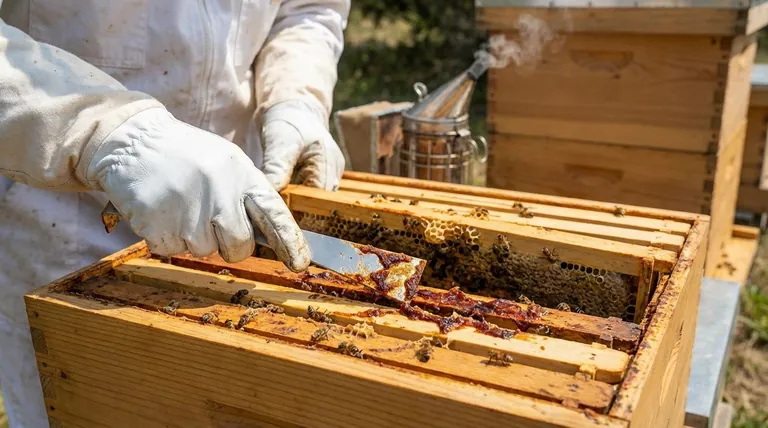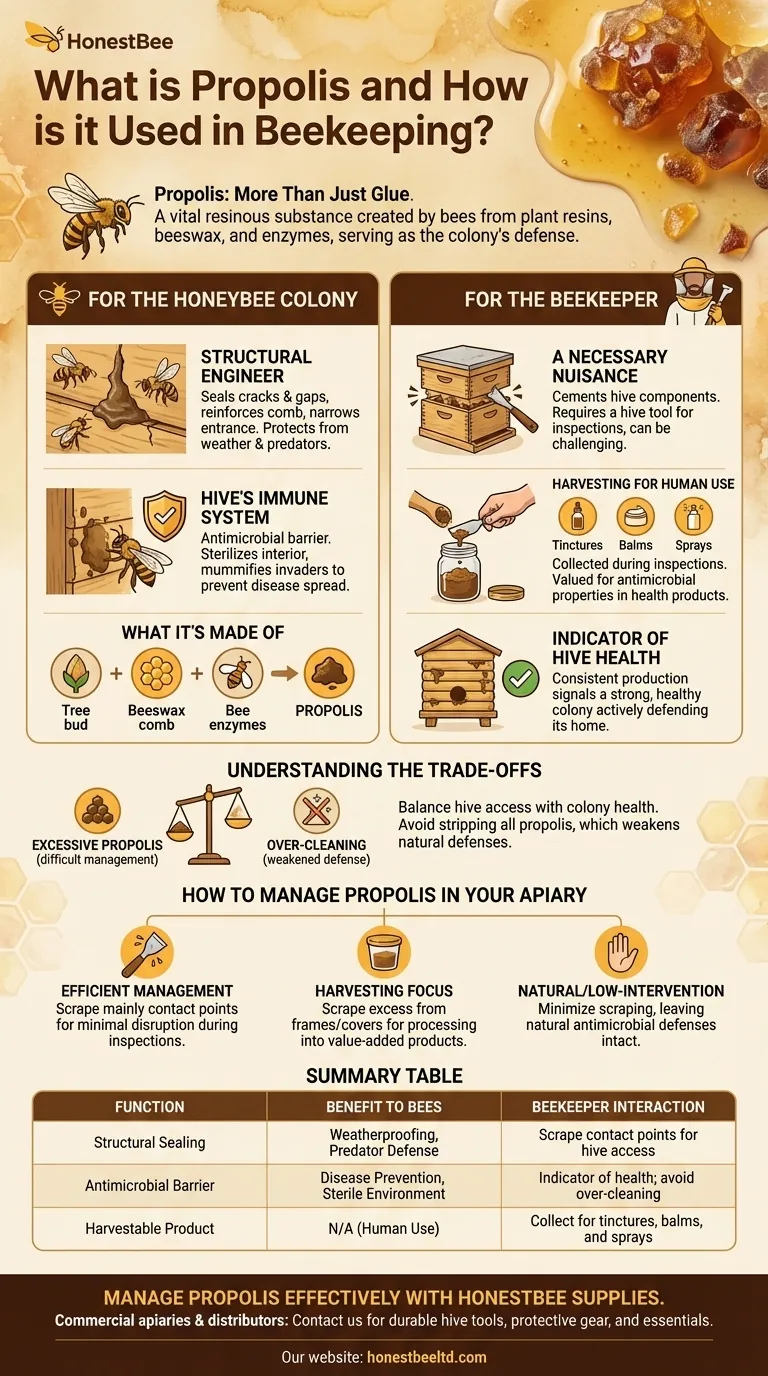In beekeeping, propolis is often treated as a sticky glue that must be scraped away, but its true function is far more critical. It is a resinous, waxy substance that honeybees create by mixing tree and plant resins with their own beeswax and enzymes, serving as the colony's primary defense mechanism. For the beekeeper, managing propolis involves a balance between ensuring hive accessibility and respecting its vital role in colony health.
While beekeepers often view propolis as a nuisance that cements hive components together, its fundamental purpose is to act as the beehive's immune system—providing structural integrity, sealing drafts, and creating a sterile, antimicrobial barrier against pathogens.

The Role of Propolis for the Honeybee Colony
To understand how beekeepers interact with propolis, we must first understand why the bees produce it. It is not a byproduct; it is a manufactured tool essential for survival.
What Propolis is Made Of
Bees create propolis by gathering sticky resins from tree buds and other botanical sources. They then blend this resin with beeswax and salivary secretions to create a malleable, waterproof, and antimicrobial putty.
The Hive's Structural Engineer
The primary use of propolis inside the hive is as a construction material. Bees use it to seal any unwanted cracks or gaps in the hive, protecting the colony from weather and predators.
They also use it to reinforce the structural integrity of the comb and to narrow the hive entrance, making it easier to defend against intruders.
The Hive's Immune System
Beyond its structural use, propolis is the colony's external immune system. The resins it's made from contain powerful antimicrobial, antifungal, and antiviral properties.
Bees coat the entire interior surface of the hive with a thin layer of propolis, creating a sterile environment. They also use it to mummify the carcasses of invaders too large to remove, preventing the spread of disease from decomposition.
How Beekeepers Interact with Propolis
A beekeeper's interaction with propolis is a direct consequence of the bees' natural instincts. What is essential for the bee can become an obstacle for the beekeeper.
A Necessary Nuisance
Bees do not differentiate between a natural crack in a tree and the man-made gaps between hive boxes or frames. They will diligently seal these spaces with propolis.
This makes hive inspections challenging, as the propolis can act like strong glue, cementing frames and boxes together. Beekeepers must use a hive tool to pry these components apart, which can disturb the colony.
Harvesting for Human Use
Instead of simply scraping it off and discarding it, many beekeepers harvest propolis. It is collected by scraping it from frames and hive boxes during inspections.
This collected propolis is valued for its use in human health products, most commonly tinctures, but also in balms, throat sprays, and other wellness items due to its antimicrobial properties.
An Indicator of Hive Health
The amount and consistency of propolis can be an indicator of a colony's health and genetics. A strong, healthy colony will actively gather resin to defend its home, so consistent propolis production is often a good sign.
Understanding the Trade-offs
Managing propolis is not simply about removal; it's about finding a balance that serves both the beekeeper and the bees.
The "Problem" of Excessive Propolis
Some bee genetics lead to excessive propolis production, which can make hive management extremely difficult. Frames can become so thoroughly glued that removing them without damaging the comb or angering the bees is nearly impossible.
The Risk of Over-Cleaning
While beekeepers need to scrape contact points to allow for easy removal of frames, it's important not to remove all propolis from the hive.
Stripping the interior hive walls of their propolis envelope can weaken the colony's natural defense against pathogens, potentially increasing stress and susceptibility to disease.
How to Manage Propolis in Your Apiary
Your approach to propolis should align with your beekeeping goals. There is no single correct method, only the one that best suits your management style and philosophy.
- If your primary focus is efficient hive management: Scrape propolis mainly from the contact points where frames rest and where hive boxes meet, ensuring you can inspect the colony with minimal disruption.
- If your primary focus is harvesting hive products: Scrape excess propolis from frames and inner covers into a clean container for later processing into tinctures or other value-added products.
- If your primary focus is natural, low-intervention beekeeping: Minimize scraping as much as possible, leaving the bees' natural antimicrobial defenses intact and only removing what is absolutely necessary to perform essential health checks.
Ultimately, understanding propolis as a sign of a healthy, functioning colony transforms it from a sticky problem into a resource to be respected and managed wisely.
Summary Table:
| Propolis Function | Benefit to Bees | Beekeeper Interaction |
|---|---|---|
| Structural Sealing | Weatherproofing, predator defense | Scrape contact points for hive access |
| Antimicrobial Barrier | Disease prevention, sterile environment | Indicator of hive health; avoid over-cleaning |
| Harvestable Product | Not applicable (human use) | Collect for tinctures, balms, and sprays |
Manage propolis effectively and stock up on essential supplies for your apiary. HONESTBEE supplies commercial apiaries and beekeeping equipment distributors with the durable tools needed for efficient hive management and product harvesting. Contact our wholesale team today to discuss your needs for hive tools, protective gear, and other beekeeping essentials.
Visual Guide

Related Products
- HONESTBEE Advanced Ergonomic Stainless Steel Hive Tool for Beekeeping
- Professional Wide Blade Honey Scraper for Beekeeping and Honey Processing
- Plastic Chinese Queen Grafting Tool for Bee Queen Rearing
- Professional Extra-Wide Uncapping Fork with Bent Tines for Beekeeping
- Honey Concentrating Vacuum Heating Thickening Machine Dehumidifier for Honey
People Also Ask
- What is the hole in a hive tool for? A Multi-Tool for Apiary Repairs and Maintenance
- How is a hive tool used for scraping and cleaning? Master Hive Maintenance for a Healthy Colony
- Why is it important to compare the progress of different hives? A Beekeeper's Key Diagnostic Tool
- How should beekeepers handle bees when using a hive tool? Master Calm, Deliberate Techniques
- What is a hive tool and what are its uses? Master Your Hive Inspections with the Essential Beekeeper's Tool



















